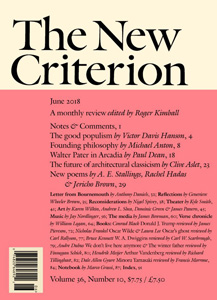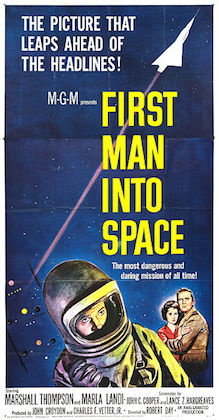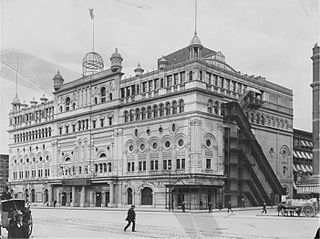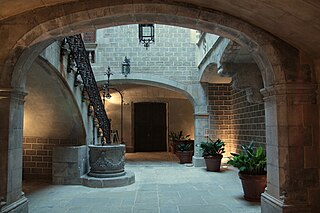
Hopscotch is a 1980 American comedy spy film, produced by Edie Landau and Ely A. Landau, directed by Ronald Neame, that stars Walter Matthau, Glenda Jackson, Sam Waterston, Ned Beatty, and Herbert Lom. The screenplay was written by Bryan Forbes and Brian Garfield, based on Garfield's 1975 novel of the same title.

The New Criterion is a New York–based monthly literary magazine and journal of artistic and cultural criticism, edited by Roger Kimball and James Panero. It has sections for criticism of poetry, theater, art, music, the media, and books. It was founded in 1982 by Hilton Kramer, former art critic for The New York Times, and Samuel Lipman, a pianist and music critic. The name is a reference to The Criterion, a British literary magazine edited by T. S. Eliot from 1922 to 1939.
Peter Cowie is a British film historian and author of more than thirty books on film. In 1963 he was the founder/publisher and general editor of the annual International Film Guide, a survey of worldwide film production, which he continued to edit for forty years.

The Criterion Collection, Inc. is an American home-video distribution company that focuses on licensing, restoring and distributing "important classic and contemporary films". Criterion serves film and media scholars, cinephiles and public and academic libraries. Criterion has helped to standardize certain aspects of home-video releases such as film restoration, the letterboxing format for widescreen films and the inclusion of bonus features such as scholarly essays and documentary content about the films and filmmakers. Criterion most notably pioneered the use of commentary tracks. Criterion has produced and distributed more than 1,000 special editions of its films in VHS, Betamax, LaserDisc, DVD, Blu-ray and Ultra HD Blu-ray formats and box sets. These films and their special features are also available via The Criterion Channel, an online streaming service that the company operates.

HeinOnline (HOL) is a commercial internet database service launched in 2000 by William S. Hein & Co., a Buffalo, New York publisher specializing in legal materials. The company was founded in Buffalo, New York, in 1961, and is currently based in nearby Getzville, New York. In 2013, WSH Co. was the 33rd largest private company in western New York, with revenues of around $33 million and more than seventy employees.

Robinson Crusoe on Mars is a 1964 American science fiction film directed by Byron Haskin and produced by Aubrey Schenck that stars Paul Mantee, Victor Lundin, and Adam West. It is a science fiction retelling of the classic 1719 novel Robinson Crusoe by Daniel Defoe. The film was distributed by Paramount Pictures and filmed in Technicolor and Techniscope.
Pulp noir is a subgenre influenced by various "noir" genres, as well as pulp fiction genres; particularly the hard-boiled genres which help give rise to film noir. Pulp noir is marked by its use of classic noir techniques, but with urban influences. Various media include film, illustrations, photographs and videogames.

The International Research Center for Japanese Studies, or Nichibunken (日文研), is an inter-university research institute in Kyoto. Along with the National Institute of Japanese Literature, the National Museum of Japanese History, and the National Museum of Ethnology, it is one of the National Institutes for the Humanities. The center is devoted to research related to Japanese culture.

The Museu Nacional d'Art de Catalunya, abbreviated as MNAC, is a museum of Catalan visual art located in Barcelona, Catalonia, Spain. Situated on Montjuïc hill at the end of Avinguda de la Reina Maria Cristina, near Pl Espanya, the museum is especially notable for its outstanding collection of romanesque church paintings, and for Catalan art and design from the late 19th and early 20th centuries, including modernisme and noucentisme. The museum is housed in the Palau Nacional, a huge, Italian-style building dating to 1929. The Palau Nacional, which has housed the Museu d'Art de Catalunya since 1934, was declared a national museum in 1990 under the Museums Law passed by the Catalan Government. That same year, a thorough renovation process was launched to refurbish the site, based on plans drawn up by the architects Gae Aulenti and Enric Steegmann, who were later joined in the undertaking by Josep Benedito. The Oval Hall was reopened for the 1992 Summer Olympic Games, and the various collections were installed and opened over the period from 1995 to 2004. The Museu Nacional d'Art de Catalunya was officially inaugurated on 16 December 2004. It is one of the largest museums in Spain.

First Man into Space is a 1959 independently made British-American black-and-white science fiction-horror film directed by Robert Day and starring Marshall Thompson, Marla Landi, Bill Edwards, and Robert Ayres. It was produced by John Croydon, Charles F. Vetter, and Richard Gordon for Amalgamated Films and was distributed by Metro-Goldwyn-Mayer.

The Olympia Theatre, also known as Hammerstein's Olympia and later the Lyric Theatre and the New York Theatre, was a theater complex built by impresario Oscar Hammerstein I at Longacre Square in Manhattan, New York City, opening in 1895.

Solaris is a 1972 Soviet science fiction drama film based on Stanisław Lem's 1961 novel of the same title. The film was co-written and directed by Andrei Tarkovsky, and stars Donatas Banionis and Natalya Bondarchuk. The electronic music score was performed by Eduard Artemyev and features a composition by J.S. Bach as its main theme. The plot centers on a space station orbiting the fictional planet Solaris, where a scientific mission has stalled because the skeleton crew of three scientists have fallen into emotional crises. Psychologist Kris Kelvin (Banionis) travels to the station to evaluate the situation, only to encounter the same mysterious phenomena as the others.
The Criterion was a British literary magazine published from October 1922 to January 1939. The Criterion was, for most of its run, a quarterly journal, although for a period in 1927–28 it was published monthly. It was created by the poet, dramatist, and literary critic T. S. Eliot who served as its editor for its entire run.
Catalan Gothic is an artistic style, with particular characteristics in the field of architecture. It occurred in the Principality of Catalonia within the Crown of Aragon between the 13th and 15th centuries, which places it at the end of the European Gothic period and at the beginning of the Renaissance. The term Catalan Gothic is confined to Barcelona and its area of influence, which has its own characteristics.

Head of a Catalan Peasant is an emblematic sequence of oil paintings and pencil made by Joan Miró between 1924 and 1925. Miró began this series the same year that André Breton published his Manifesto of Surrealism. The series was made partly in Paris. For Joan Miró "a peasant" symbolized rural knowledge, and also reflected his Catalan identity.

The Fundació Vila Casas, founded in 1986 by the pharmaceutical entrepreneur Antoni Vila Casas, is a private, non-profit organisation which has the promotion of contemporary Catalan art as its main aim.

Can Framis is the latest Fundació Vila Casas museum, an art center in Barcelona devoted to the promotion of contemporary Catalan painting. Located in the old Can Framis factory complex, the museum displays more than 250 paintings from the sixties to the present made by artists born or currently living in Catalonia. In addition to the permanent collection which is divided in three floors, Can Framis Museum has an area dedicated to temporary exhibitions named Espai Aø. The permanent collection is updated periodically, and two new temporary exhibitions are opened every three months.

The Palau Solterra Museum is one of the cultural centers of the Vila Casas Foundation located, located in the palace of the same name in Torroella de Montgrí (Girona), a town of the Baix Empordà region. It opened in 2000, and nowadays it houses about three hundred contemporary photographs of the city, artists from various parts of the world, including Chema Madoz, Alberto García Álix, Toni Catany, Otto Lloyd, Xavier Miserachs, Ouka Lele and Frank Horvat, among many others.
Modernist film is related to the art and philosophy of modernism.













